In the world of interior design, the focal point is an essential, irreplaceable element when planning any visual space. It is the part of the room that naturally captures the eye first and directs attention toward it. Whether it’s a large piece of art, a fireplace, or even a striking piece of furniture, the focal point plays a key role in creating visual balance and building harmony among the various design elements.
The importance of the focal point in interior design lies in its ability to organize the movement of the eye within the space. It acts as a visual guide that leads the viewer from one part to another in a smooth and logical way. This feature is known as “visual hierarchy” or “visual flow,” and it is crucial for preventing feelings of confusion or visual chaos within the room.
Moreover, the focal point serves as the room’s “visual window” — the first outlet that gives the viewer an initial impression of the space’s personality and function. Its significance extends beyond aesthetics, encompassing both emotional impact and functional clarity
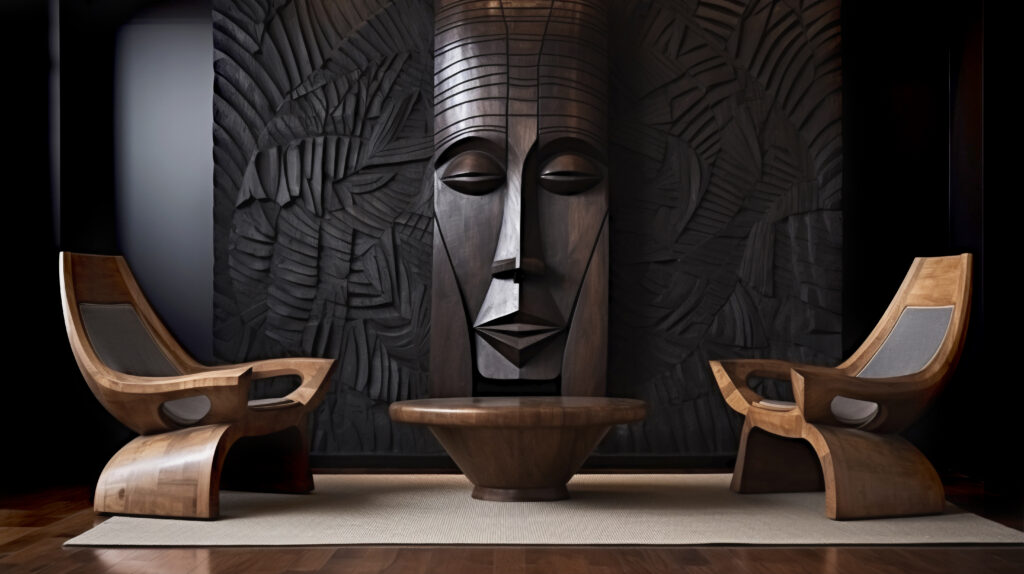
The Psychology Behind Focal Points
To understand the importance of the focal point in interior design, one must delve a bit into human visual behavior and the psychology of perception. When a person enters any space, their eyes instinctively begin searching for a standout element — something that draws attention and gives the mind a sense of order and structure. This instinctive behavior is known in design as “visual attraction,” and it relies on the presence of a clear anchor that puts the eye at ease and reduces distraction.
Typically, the eye is first drawn to elements that feature strong color contrast, prominent size, or strategic positioningwithin the space — and these are precisely the traits that define a successful focal point. When this element is used correctly, the design becomes more cohesive and fluid, enhancing the overall user experience within the room.
But the impact of a focal point goes beyond just what we see — it also influences emotions and psychological impressions. A strong focal point — such as a glowing fireplace or a vibrant piece of artwork — can evoke feelings of warmth, comfort, or even creativity. It reinforces the room’s identity and leaves a lasting imprint on the memory of its visitors. That’s why a thoughtfully designed focal point serves not only aesthetic purposes but also builds an emotional connection between the individual and the space.
Common Types of Focal Points in Interior Design
The focal point in interior design serves as the foundation around which the entire space is coordinated. Choosing the right focal point isn’t just about taste — it depends on the function of the room, the lighting conditions, and where the eye naturally lands when entering the space. Here’s a detailed breakdown of the most common types:

1. Architectural Elements like Large Windows or Arches
One of the most popular focal points in open spaces is a large or panoramic window, especially if it opens onto a natural view or garden. It immediately draws attention as you enter the room and creates a sense of openness and visual comfort. Likewise, an architectural arch or decorative column can become a stunning focal point, particularly when highlighted with lighting or luxurious materials like marble or natural wood.
2. Standout Furniture or Decorative Pieces
In many design settings, a unique piece of furniture is used as a central focal point. For example:
- A large television mounted on a dedicated feature wall can be the strongest visual anchor in a living room, especially when paired with built-in storage or a decorative media wall.
- A console table decorated with an artistic mirror or eye-catching vase can serve as a visual highlight in the entryway or behind the sofa.
- A large piece of art or a uniquely framed mirror becomes an instant attention-grabber when placed on the right wall and supported by proper lighting.
3. Feature Walls
A feature wall is a clever design trick for creating a focal point without the need for additional furniture or accessories. It can be crafted in several creative ways:
- Using natural stone like marble or sandstone.
- Installing vertical or horizontal wooden panels to add warmth and texture.
- Painting the wall a bold or dark color that contrasts with the rest of the space to establish strong visual impact.
Feature walls are especially effective because they add depth to a room and introduce a unique character — all without occupying extra physical space.
4. Fireplaces or Televisions as Visual Centers
In classic interior design, the fireplace has always served as the natural focal point in living or sitting rooms. This concept still holds true today, particularly when the fireplace is finished with a striking material like marble, stone, or rich wood.
In modern homes, the television often plays this role — especially when integrated into a stylish background such as a stone or wood panel wall, or built into a custom media unit that balances storage and aesthetics.
5. A Distinctive Piece of Furniture or Striking Artwork
Sometimes, a focal point doesn’t need to be architectural or oversized. A bold-colored sofa, an unusually shaped chair, or even a sculptural piece with cultural value can serve as a powerful visual element. Though seemingly simple, these items can create a significant design impact when placed strategically and enhanced with focused lighting.
How to Choose the Right Focal Point Based on Room Type
Choosing the focal point in interior design is not a one-size-fits-all decision, nor should it be randomly repeated across rooms. Each space in the home has its own purpose and unique visual needs. Here’s a detailed guide to help you determine the ideal focal point for each room type:
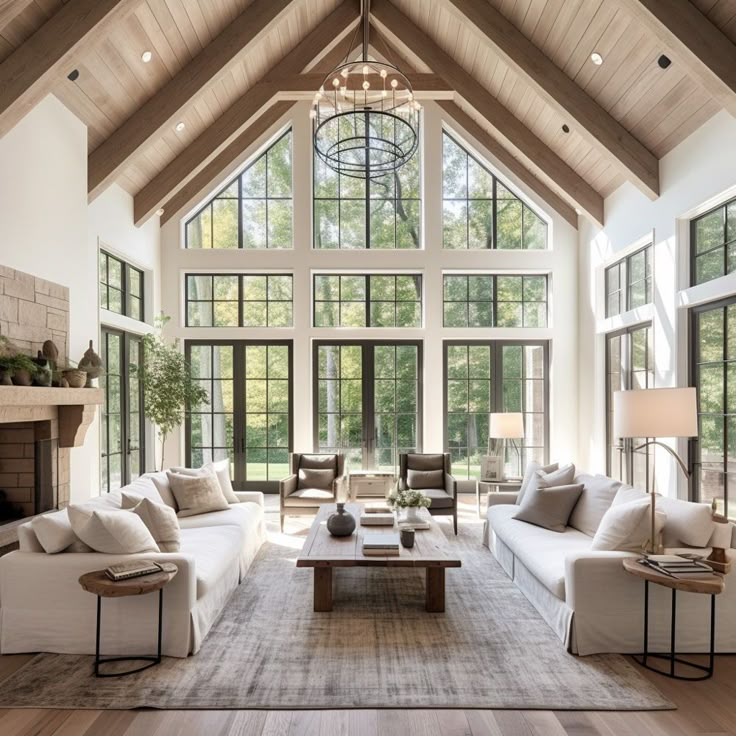
1. Living Room
The living room is often the heart of the home — a space where people gather, relax, and socialize. That’s why its focal point should be strong and instantly recognizable. The most common options include:
- Television: Mounted on a dedicated wall and paired with a sleek media unit.
- Fireplace: A timeless choice, especially in traditional or rustic-style homes.
- Large artwork: Positioned above the main sofa, it adds a sophisticated visual anchor.

2. Bedroom
In the bedroom, calmness and privacy prevail. Thus, the focal point should be subtle yet visually impactful. Top choices include:
- Headboard: Especially if it’s upholstered, oversized, or ornately designed in wood.
- Accent wall behind the bed: Can be styled with soft wallpaper patterns or painted in a contrasting color.
- Pendant lighting or stylish bedside lamps: Provide elegance and create a soft focal draw.
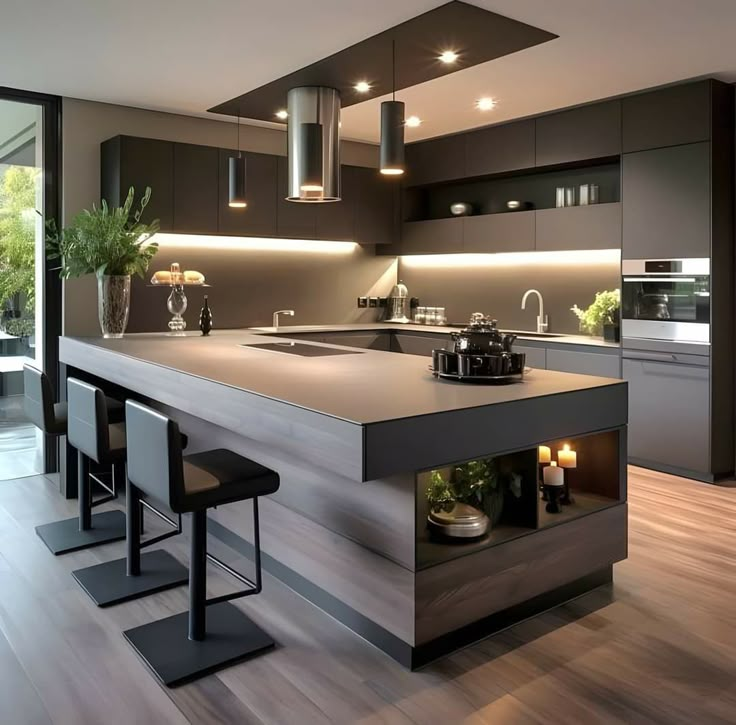
3. Kitchen
Though the kitchen is a functional space, modern design encourages including a stylish focal point. Great options include:
- Kitchen island: Particularly if it features a bold color or an eye-catching marble countertop.
- Range hood: When clad in premium materials like copper or natural wood, it becomes an instant standout.
- Backsplash: A bold tile design or mosaic pattern can turn the cooking area into a stunning visual highlight.

4. Bathroom
In the bathroom, the focal point is often subtle but visually effective. Smart options include:
- Mirror with a distinctive frame or shape: Ideal for catching the eye with minimal effort.
- Decorative vanity: With a marble countertop and well-placed lighting to draw focus.
- Glass shower area or bold-tiled shower wall: Especially when featuring unique textures or contrasting colors.
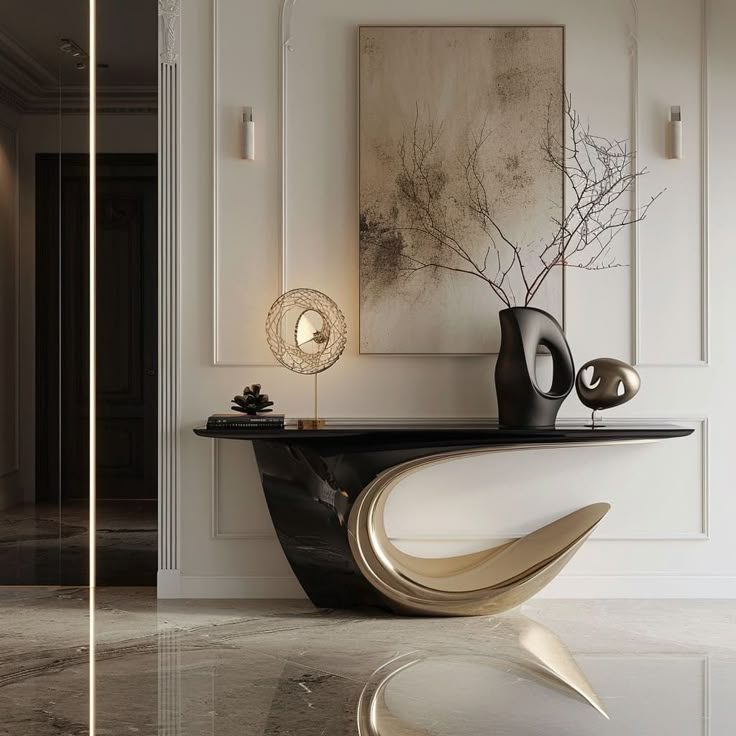
5. Entrances and Hallways
Despite their small size, these transitional spaces benefit greatly from a focal point to add character and visual interest:
- Console table with a mirror or artwork above: Sets the tone as soon as someone enters the home.
- Statement ceiling lighting: Like modern chandeliers or pendant lights that elevate the atmosphere.
- Wall art or a gallery of family photos: Adds a personal and visually engaging touch.
Using Artwork as a Focal Point
Artwork — especially paintings — is one of the most elegant and versatile choices when it comes to establishing a focal point in interior design. Not only does it add visual beauty, but it also reflects personal taste and character, giving the room an artistic and cultural identity. However, to achieve the desired impact, selecting a beautiful piece isn’t enough. Three key factors must be considered: size, placement, and lighting.
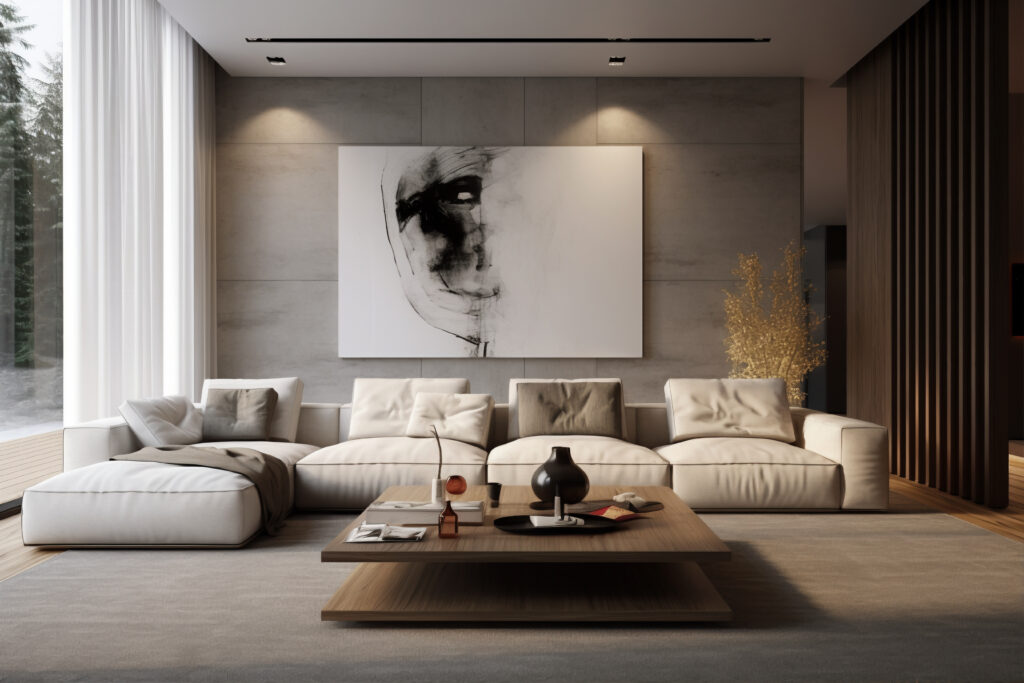
1. Choosing the Right Size and Style
The first step in using artwork as a focal point is ensuring that its size is proportionate to the wall and the overall space. Here are some essential guidelines:
- In large rooms, it’s best to choose oversized artwork or a collection of pieces (like a triptych or gallery wall) that fills the wall and creates visual balance.
- In smaller rooms, a medium-sized piece will suffice — as long as it is bold and distinctive in design and color.
- The artistic style should complement the room’s overall design. For example, abstract art works well in modern interiors, while classical or naturalistic artwork suits traditional or rustic spaces.
2. Positioning the Artwork for Impact
How and where you hang the artwork plays a significant role in its effectiveness as a focal point. Some key rules include:
- The artwork should be at eye level, with the center approximately 140–150 cm (55–60 inches) from the floor.
- If hung above a piece of furniture (like a sofa or console), the artwork should be narrower than the furniture and placed 20–25 cm (8–10 inches) above it.
- Avoid placing multiple artworks randomly across different walls in the same room, as this can create visual clutter and reduce the clarity of the focal point.
3. Lighting the Artwork Properly
Lighting is a crucial element that determines how prominently a piece of art stands out. It can transform a simple decoration into a powerful visual centerpiece. Consider using:
- Spotlights: Directed lighting from above or the sides to highlight the piece directly.
- LED strips: Hidden behind the frame or embedded in the wall, they add a soft, contemporary glow.
- Natural light: Hanging artwork opposite a window (without direct sunlight exposure) can be enough to reveal its beauty during the day.
In summary, when a piece of artwork is chosen thoughtfully, positioned precisely, and supported with proper lighting, it becomes a strong and effective visual anchor — enriching the overall interior scene and adding depth both visually and emotionally.
The Fireplace as a Natural Focal Point
The fireplace is one of the oldest and most powerful design elements used as a natural focal point in interior spaces — particularly in living rooms. It’s not merely a source of warmth; it’s a striking architectural feature that draws attention and creates a sense of comfort and coziness. When styled correctly, the fireplace becomes the true heart of the room, defining both the layout and the style of the surrounding furniture.
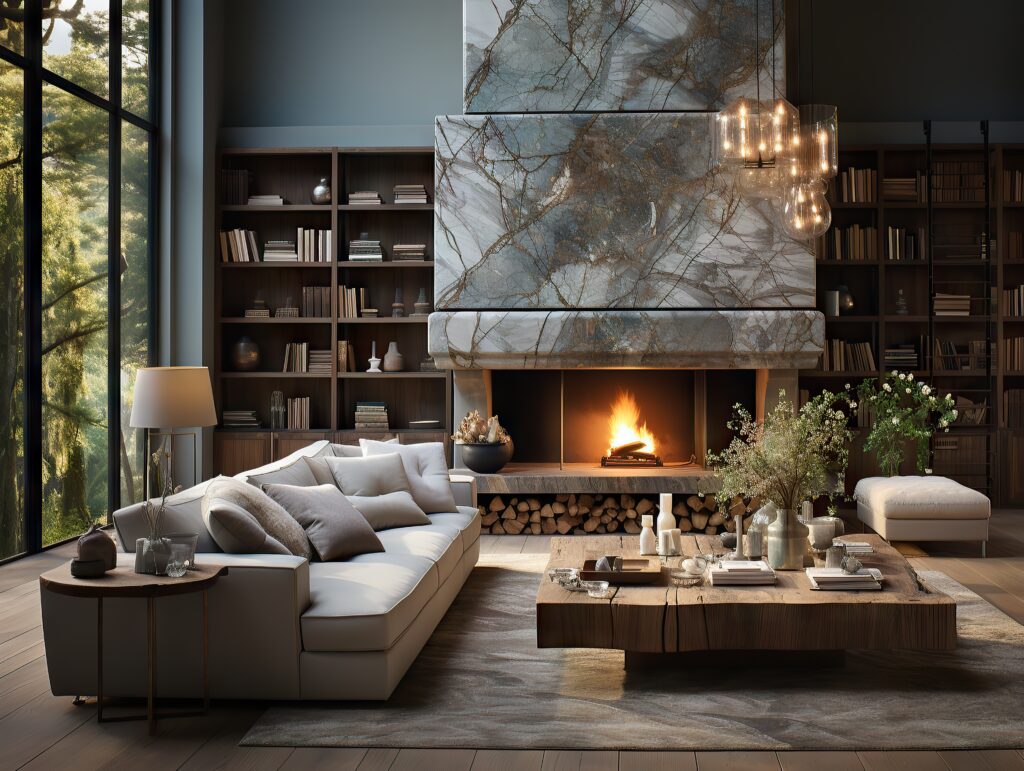
Classic vs. Modern Fireplaces
- Classic fireplaces are distinguished by ornate architectural details and are often made from natural stone or carved wood. They bring a touch of timeless elegance and are well-suited for rustic, Victorian, or French-style interiors. This type often pairs beautifully with a large mirror or an artwork placed above the mantel to enhance its visual impact.
- Modern fireplaces, on the other hand, emphasize simplicity and fluidity. They feature clean lines and materials such as glass, metal, or concrete. These fireplaces often integrate seamlessly into the wall or appear as sleek horizontal flame strips. They work perfectly in contemporary or industrial interiors and can be paired with a television above without compromising their design appeal.
Mantel Styling Tips
The mantel — the upper shelf of the fireplace — plays a crucial role in reinforcing the fireplace as a focal point in interior design. Styling it thoughtfully enhances its visual presence:
- Visual balance: Place objects of varying heights on either side, such as candleholders or vases, with a central focal piece like a mirror, wall clock, or artwork.
- Layering: Don’t settle for a single object. Create depth by layering — for example, place a framed print at the back with smaller decorative items like books or bowls in front.
- Repetition and symmetry: Using repeated elements brings harmony, but breaking the symmetry slightly can introduce a relaxed and personal feel.
Coordinating Furniture Layout Around the Fireplace
To ensure the fireplace remains the focal point of the room, it’s essential to arrange furniture in a way that visually emphasizes it:
- Position the main sofa to face the fireplace, if possible, or angle it slightly toward it.
- Use an area rug to define the zone around the fireplace and establish it as an independent visual center.
- Avoid placing tall or bulky furniture directly beside the fireplace, as this may obstruct the view or reduce its prominence as the design’s centerpiece.
When all these elements are combined, the fireplace becomes a fully integrated visual and aesthetic feature — not just a source of warmth, but also a stylish and captivating anchor within any space.
Combining Multiple Focal Points in Interior Design
While the basic design principle recommends having one clear focal point per room, some spaces — especially large or open-plan areas — naturally call for more than one visual anchor. The challenge lies not in having multiple focal points, but in coordinating them harmoniously so they don’t compete or cause visual clutter.
When and How to Use More Than One Focal Point
- You can use two or even three focal points in a single room, as long as one of them is visually dominant and serves as theprimary center of attention.
- The secondary focal points should be supportive or complementary, enhancing the overall atmosphere without drawing too much focus.
- Ideally, focal points should be arranged with variation in height, color, or material, while still maintaining visual cohesion between them.
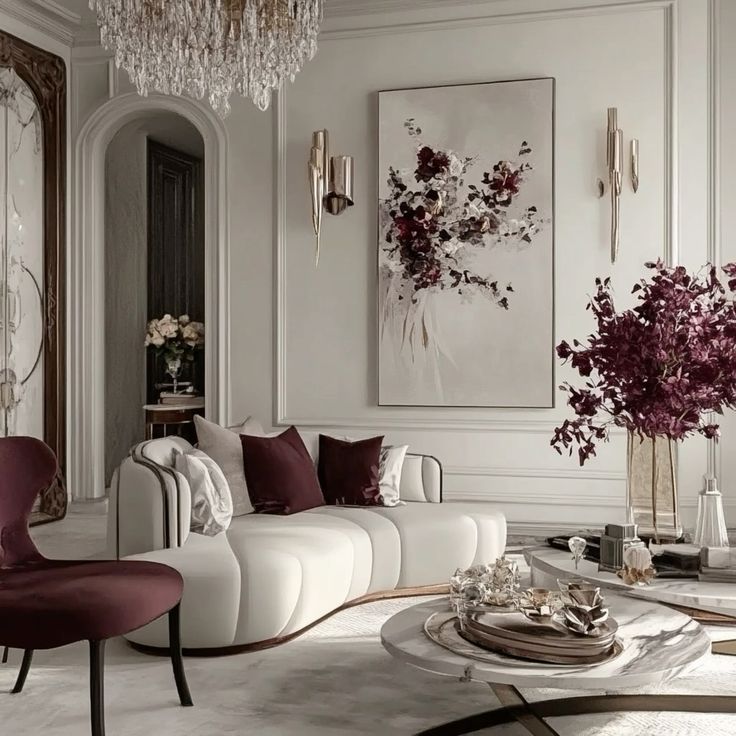
Maintaining Visual Harmony Among Focal Points
Achieving balance among multiple focal points involves:
- Visually dividing the room into zones, where each zone has its own focal element (e.g., a TV wall on one side, and a reading nook with artwork in another corner).
- Using a cohesive color palette that links all focal areas together.
- Relying on strategic lighting to highlight each point without overwhelming the others.
- Preserving visual breathing space around each focal element so that every piece has its own moment to shine.
Example: Combining a Console Table and Mirror
A simple and effective example of dual focal points is using a console table with a large mirror above it as a secondary focal pointin a room where a fireplace or TV acts as the main one.
- The mirror helps expand the sense of space and reflects light, enhancing the presence of the console and giving it visual value.
- You can decorate the console surface with vases, candles, or small art pieces, creating a layered yet uncluttered effect.
- Placing this ensemble in an entryway or opposite the main focal point balances the layout and completes the room’s visual story.
Other simplest and most effective examples in design is using a bold and contrasting color as a focal point, either as a primary or supporting element — especially when complemented by smart surrounding details.
For instance, introducing a burgundy tone into the space — whether through a standout chair, curtains, or an art piece — can make an immediate visual impact. Burgundy carries a rich depth that naturally draws attention and adds warmth and sophistication to the space without requiring complex décor.
When paired with a wall artwork that either harmonizes with or complements its tones, this creates a seamless blend between a color-based focal point and a visual focal point. Rather than competing, the elements guide the eye gently and reinforce the room’s overall cohesion.
This combination can be subtly echoed through small touches like patterned cushions or vases in the same color family, repeating the color element thoughtfully to enhance its effect without overwhelming the space.
Ultimately, using color as a focal point is one of the most flexible yet bold strategies in interior design. But it requires a delicate sense of balance — when executed thoughtfully, color transforms from a background element into a strong and present character in the design narrative.
In Summary
Yes, it’s entirely possible to combine multiple focal points in interior design, provided it’s done with taste and intention. Each focal point should have a clear role and visual clarity — not compete for attention. When executed properly, the result is a rich, layered design that delights the eye and reveals the personality of the space with depth and elegance.
Rules for Distributing Elements Around a Focal Point
Once the focal point in interior design is determined, the next crucial step is how to arrange the rest of the room’s elements around it to achieve visual harmony and smooth eye movement. There are three main aspects to consider: furniture arrangement, directed lighting, and the use of colors and materials.
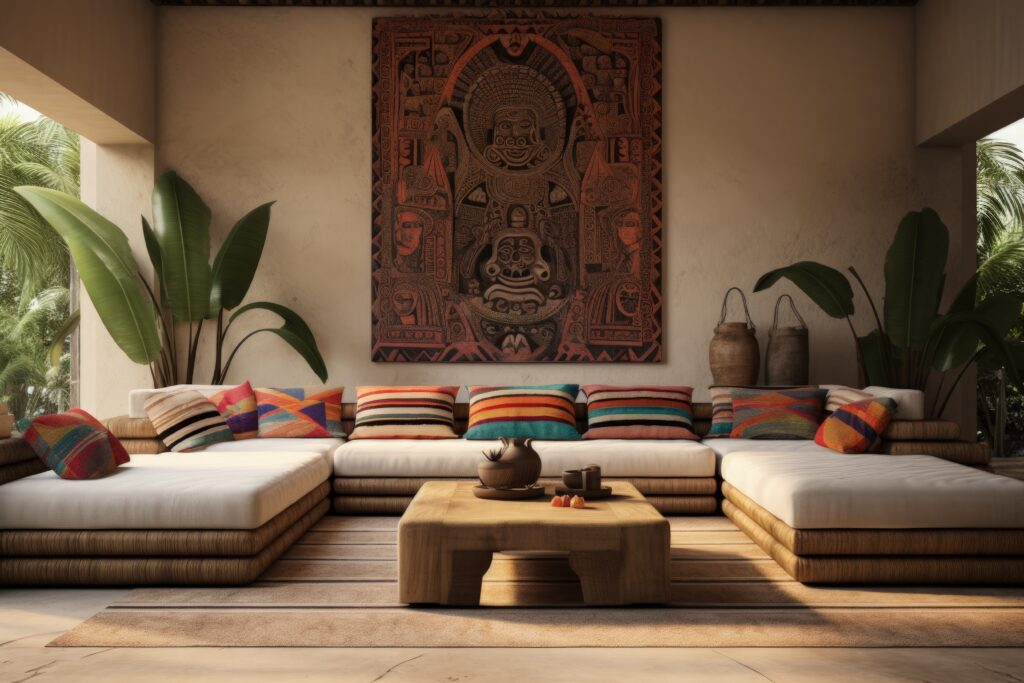
1. Furniture Arrangement
- Orienting toward the focal point: Key pieces of furniture — such as sofas, chairs, and tables — should face the focal point directly or be angled in a way that visually directs attention toward it.
- Mindful spacing: Leave adequate space between the furniture and the focal point to create “visual breathing room,” allowing the focal element to stand out without feeling cramped.
- Balance: Distribute furniture evenly around the focal point to avoid making one side of the room feel visually heavier than the other. Use smaller items, like side tables or accent chairs, to balance larger pieces on the opposite side.
2. Directed Lighting
Lighting plays a vital role in guiding the eye and highlighting the focal point. There are several techniques you can apply:
- Ceiling-mounted spotlights: These can be installed to shine directly on a piece of art, a fireplace, or a feature wall.
- Floor or table lamps: Perfect for illuminating furniture or décor elements placed next to the focal point.
- Ambient or accent lighting: Such as LED strip lights behind a TV or above a console, these add a soft glow that enhances the focal area without causing glare or distraction.
3. Choosing Colors and Materials to Enhance the Focal Point
Colors and textures are powerful tools that help guide visual attention toward the focal point:
- Color contrast: Use a bold or dark color on the wall behind the focal element, while keeping the rest of the space in neutral tones. For example, a stone wall behind a fireplace will naturally stand out in a room with white walls.
- Diverse materials: Incorporating wood, stone, or metal on the focal element or its background adds texture and depth, amplifying its visual impact.
- Repeating elements: Echoing colors or patterns from the focal point in accessories like cushions or decorative objects helps lead the eye and visually connect the design.
By applying these principles, the focal point in interior design becomes more than just a static visual element — it transforms into a dynamic anchor that unifies the room and creates a strong sense of cohesion throughout the space.
Common Mistakes in Determining or Implementing a Focal Point
Choosing a focal point in interior design is an art in itself, but executing this concept incorrectly can disrupt visual balance and make a space feel cluttered or incomplete. Below are the most common mistakes to watch for — and avoid — when dealing with focal points in any room:
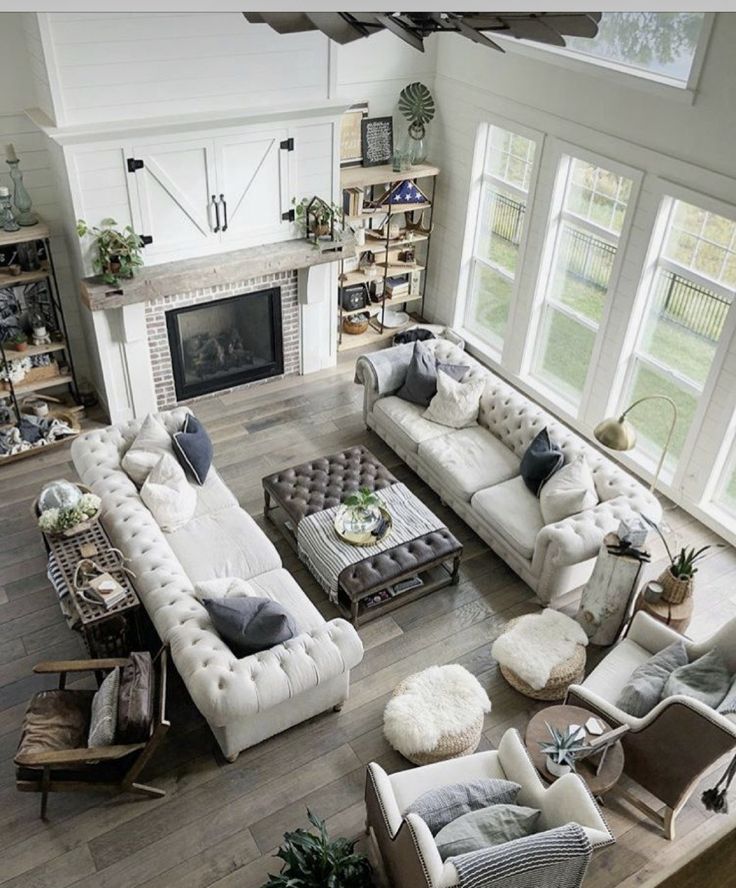
1. Visual Clutter from Conflicting Focal Points
One of the most frequent mistakes is trying to create multiple dominant focal points in the same room without a clear visual hierarchy. This leads to scattered attention and no logical visual direction. For instance, placing a large painting, a TV, and a fireplace all on the same wall without clear visual separation can make the room feel chaotic and overwhelming.
2. Ignoring Balance Between the Focal Point and the Space
Even if the focal point is visually strong, neglecting the overall balance of the room can diminish its impact. The focal element must be proportionate to the room’s dimensions — not too small that it feels insignificant, and not too large that it overpowers the surrounding elements. Achieving visual balance allows the eye to rest comfortably and enhances the overall design experience.
3. Not Supporting the Focal Point with Surrounding Elements
A focal point cannot stand on its own. It requires supporting elements to strengthen its presence — such as appropriate lighting, complementary colors, or furniture arrangement that guides attention toward it. Without these, the focal point can appear isolated or disconnected from the rest of the design.
4. Competing Rather than Complementary Focal Elements
Having several bold elements in the same space — like a vibrant wall color, a large artwork, and a patterned sofa — can result in visual competition rather than harmony. The solution is to identify one primary focal point and build the rest of the design around it with complementary elements, not rivals.
5. Poor Scale or Proportion
Choosing the wrong size or scale can completely undermine the impact of a focal point. For example, a small painting on a large wall will look lost, while an oversized mirror in a narrow hallway may create a sense of visual congestion. Always consider the room’s proportions when selecting and positioning focal elements.
6. Overstyling or Cluttered Composition
Sometimes, the desire to impress leads to over-decorating the focal point with too many objects or accessories. This excess reduces the impact of each individual piece and results in a visually noisy environment. The golden rule here is: “Less is often more.”Simplicity, when intentional, carries more power than overcomplication.
Inspiring Ideas for Innovative Focal Points
While many interior designs rely on traditional elements like fireplaces or TVs as focal points, there’s a growing trend toward creativity and distinction through unconventional focal points that give a space a unique character and personalized touch. Here are some inspiring ideas for creating a focal point in interior design with bold and imaginative style:

1. Large Artwork
Choosing a large-scale piece of art with strong visual impact can dramatically transform any room, even a modest one. The best artworks are those that reflect your personal taste or tell a story, adding emotional depth to the space. To enhance the artwork’s presence, use directional lighting and a neutral background that allows the piece to stand out even more.
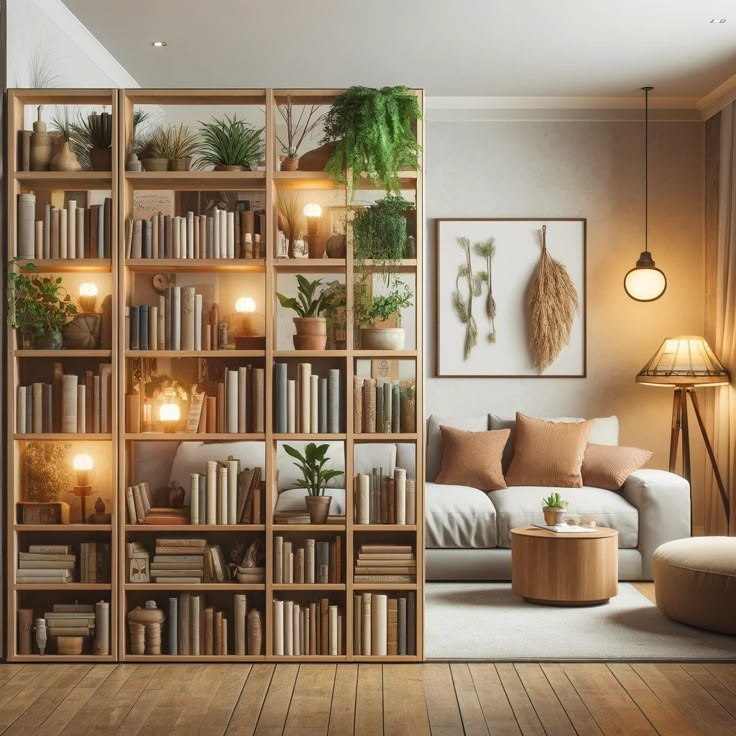
2. Unconventional Bookcases or Wall Shelves
A clever and innovative way to turn a functional piece into a compelling focal point is by using a wall-mounted bookshelf or shelving unit with a unique geometric design. Shapes like hexagons, intersecting lines, or tree-branch-inspired forms instantly grab attention.
These designs add a modern and dynamic feel to the wall and provide visual movement, especially when the shelves are carefully styled with books, plants, and decorative objects.
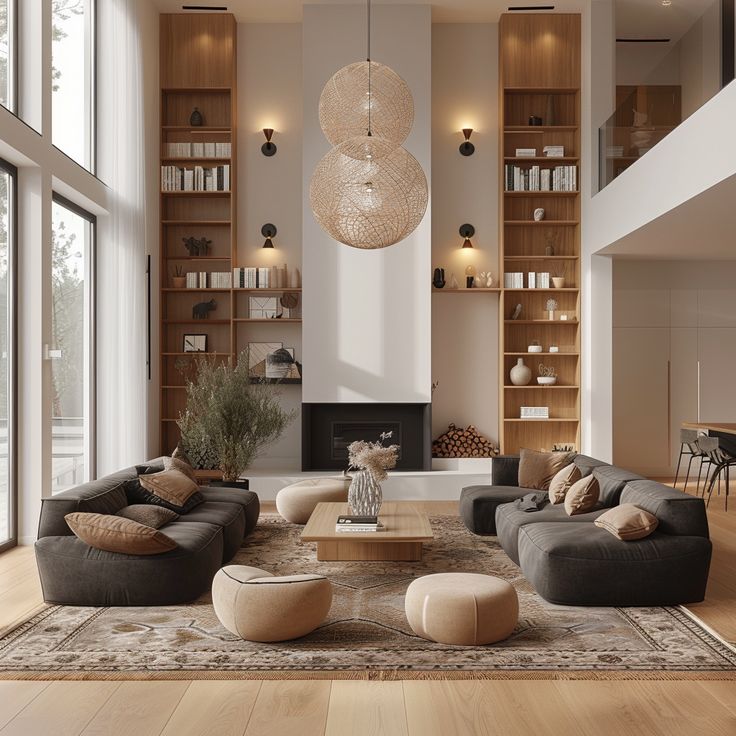
3. Geometric Ceiling Designs or Dazzling Lighting
The ceiling is often overlooked in interior design, despite being a vast and impactful surface. Incorporating bold geometric structures or crossed wooden beams can add architectural interest and turn the ceiling into a visual centerpiece.
Likewise, statement lighting, such as glamorous chandeliers or sculptural pendant lights, can easily become the main focal point — especially in dining rooms, entryways, or above central tables.
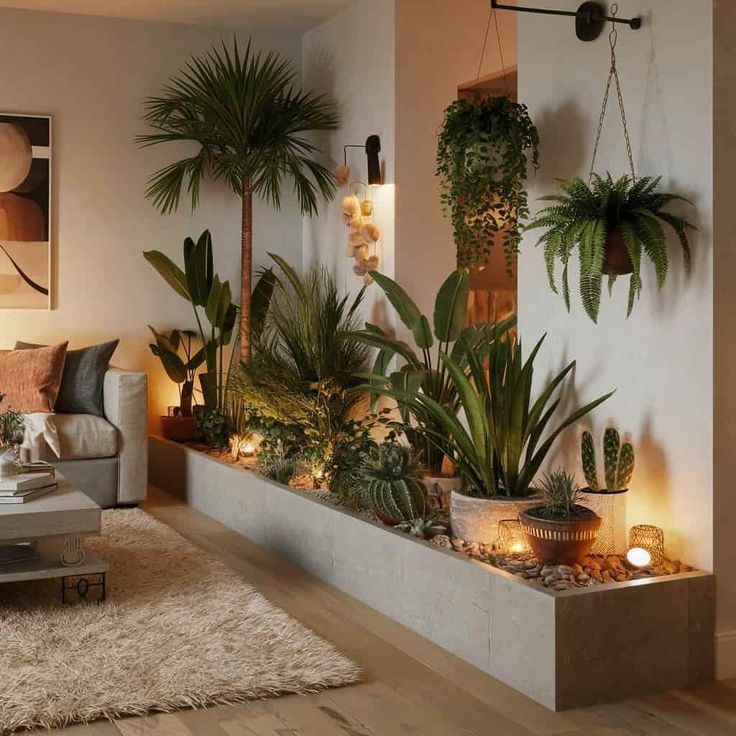
4. Using Indoor Plants as a Vibrant Focal Point
Plants are not just decorative accents — they can serve as effective natural focal points that bring life and serenity into a room. A tall plant like a fiddle leaf fig or an elegant indoor tree in a stylish pot can fill an empty corner and attract attention in a soft, organic way.
You can also install a green living wall in a living room or even a luxury bathroom to create a standout element that combines beauty with the trending natural aesthetic in modern interiors.
Zory’s Touch: How Can Artificial Intelligence Help You Determine Your Focal Point?
With the advancement of artificial intelligence in the world of interior design, it has become possible for anyone — even non-experts — to accurately identify the focal point in interior design for their space, in a way that is both scientific and creative.
“Zory’s Touch” is an example of such smart tools that can revolutionize the way focal points are selected and planned. It provides recommendations based on intelligent algorithms and instant visual analysis.
1. Providing Visual Designs to Help You Choose
AI-powered design tools allow users to upload a photo of their room. The AI then analyzes the furniture layout, lighting, and color contrast points, and suggests multiple design arrangements that clearly highlight a specific focal point.
These visual mock-ups may include ideas such as:
- A feature wall painted in a bold color behind the sofa.
- A large piece of artwork paired with accent lighting.
- A console table and mirror ensemble placed in a narrow entryway to enhance spatial depth.
2. Generating Creative Suggestions Based on Space and Existing Furniture
Thanks to intelligent design engines like Zory, the system can identify the room’s style profile — whether it’s classic, modern, boho, or industrial — as well as evaluate the size of the space and existing furnishings. Based on this, it can automatically generate suggestions such as:
- The most suitable focal point location (e.g., the wall behind the sofa or the corner opposite a window).
- Recommendations for items to add or reposition to strengthen the focal point.
- Visual alerts to avoid common mistakes like overcrowding or excessive ornamentation.
Using these interactive insights, users can make well-informed design decisions supported by logical analysis and clear visual representation — reducing the likelihood of error while saving time and budget.
Tips from Interior Designers
When it comes to choosing and styling a focal point in interior design, seeking the advice of professionals can make a real difference. Experienced designers don’t view the focal point as just a visual feature — they see it as part of a story each room is meant to tell. Here are some trusted insights shared by interior design experts:
1. Focus on the feeling, not just the form
“The best focal point isn’t necessarily the most expensive or elaborate — it’s the one that makes the room feel like it revolves around it.”
— Sarah Devlin, American interior designer
Start by asking yourself: What emotion do you want people to feel when they walk into the room? Warmth? Sophistication? Calm? Then choose a focal point that supports that feeling — whether it’s a fireplace, a bold piece of art, or a large window pouring in natural light.
2. Don’t be afraid to be bold — with balance
“People are often afraid to take risks in design. But well-calculated boldness is what makes a space memorable.”
— Jonathan Baker, interior architect and founder of a luxury London studio
Selecting a dramatic color, a large-scale artwork, or a unique ceiling design as a focal point can create incredible impact — just make sure it complements, rather than competes with, the other elements in the room.
3. Lighting can make or break a focal point
Most designers agree: the right lighting is the secret ingredient to a successful focal point. An expensive painting loses its presence in a dark corner. Use directed lighting or smart ambient lighting to highlight the main element and give it the attention it deserves.
4. Match the focal point to the room’s function
“Not every room needs the same type of focal point. What works in a living room might feel out of place in a bedroom.”
— Marilyn Shaw, visual coordination consultant
Choose your focal point based on the room’s function — a TV makes sense in a living room, while a stylish mirror or an elegant headboard is more appropriate for a bedroom.
5. Simplicity can be more powerful than complexity
Many experts emphasize that an effective focal point doesn’t need to be excessive — it simply needs clarity of purpose and harmony with its surroundings. Sometimes, a sleek console table with a geometrically framed mirror is all it takes to create visual appeal and calm in an entryway.
Frequently Asked Questions (FAQs)
1. Can a room have more than one focal point?
Yes, a room can have more than one focal point, especially if the space is large or open-concept. However, it’s essential to designate one primary focal point while the others act as supporting elements. Visual balance is key — the focal points should complement each other rather than compete.
2. How do I choose a focal point in a small space?
In smaller rooms, it’s best to select a simple but impactful focal point, such as a wall-mounted artwork, a uniquely designed mirror, or a built-in storage unit in a standout color. Avoid overcrowding the room with too many elements — one well-chosen item can easily stand out on its own.
3. What’s the best focal point for open-concept living areas?
In open-concept designs, a strong, unifying focal point is ideal — something that visually connects the different zones. This could be a decorative stone wall, a central fireplace, or a large furniture piece like a kitchen island or a bold dining table. Lighting can also help reinforce this visual center.
4. Is the TV always the best focal point for living rooms?
Not necessarily. While the TV is commonly used as a focal point for functional reasons, it’s not the only option. Other stylish alternatives include a fireplace, a feature wall, or a large piece of art. The best choice depends on your lifestyle and design preferences, as well as the need for overall visual harmony in the space.
5. How can I use lighting to enhance a focal point?
Lighting is a powerful tool in highlighting a focal point in interior design. Use spotlights to draw attention to artwork or accent walls, or install soft backlighting behind specific elements to add depth and elegance. Chandeliers and floor lamps can also serve as focal features or help support the main point of focus.
Conclusion
In the end, the focal point in interior design is far more than just a decorative detail — it is a fundamental element that gives each room a clear identity and a comfortable visual flow. It’s the anchor around which everything revolves — from furniture arrangement to color selection, from lighting to the overall feel of the space.
Every room, no matter how small or simple, deserves a focal point that defines it and expresses its function and soul. Whether it’s a classic fireplace, modern artwork, a sleek console table, or even a lush green corner with plants, the most powerful element is the one that speaks to the eye… and resonates with the heart.
And remember — design is both an art and a journey. Experiment. Explore. Evolve. There is no single right answer, only countless possibilities that reflect who you are and transform your space into something deeply personal.
Find the visual center of your home — and perhaps, along the way, discover your own inner center too.
